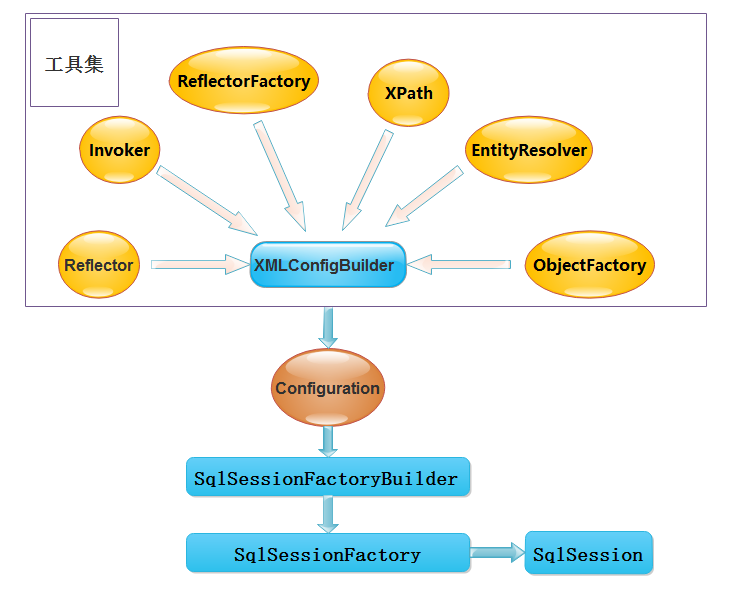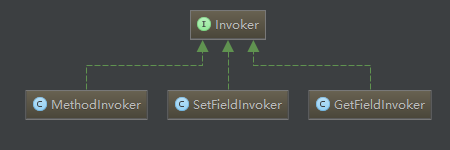MyBatis初始化背后的"男人":解析器
Mybatis的初始化过程,就是组装Configuration的过程,在这个过程中,用到了一些工具,我列举了六个基本工具,如图所示。

图中展示了XMLConfigBuilder为了组装出Configuration对象所作出的努力,配备了至少六个基本工具。本文的重点,就是分析这六个工具的作用。
好怕怕啊,一下子分析六个那么多。别怕,每个工具不超过三行代码,你就会彻底明白(相信你自己)。
1. ObjectFactory
ObjectFactory objectFactory = new DefaultObjectFactory();
List<String> list = objectFactory.create(ArrayList.class);
list.add("apple");
System.out.println(list);
out put:
[apple]
ObjectFactory:反射创建对象工厂类。
2. Reflector、Invoker、ReflectorFactory
ObjectFactory objectFactory = new DefaultObjectFactory();
Student student = objectFactory.create(Student.class);
Reflector reflector = new Reflector(Student.class);
Invoker invoker = reflector.getSetInvoker("studId");
invoker.invoke(student, new Object[] { 20 });
invoker = reflector.getGetInvoker("studId");
System.out.println("studId=" + invoker.invoke(student, null));
output:
studId=20
代码逻辑:使用默认构造方法,反射创建一个Student对象,反射获得studId属性并赋值为20,System.out输出studId的属性值。

Invoker:反射类Class的Method、Field封装。
-
GetFieldInvoker等于从Field取值:field.get(obj)。
-
SetFieldInvoker等于给Field赋值:field.set(obj, args[0])。
-
MethodInvoker等于Method方法调用:method.invoke(obj, args)。
Reflector:保存一个类Class的反射Invoker信息集合。
DefaultReflectorFactory。
private final ConcurrentMap<Class<?>, Reflector> reflectorMap = new ConcurrentHashMap<Class<?>, Reflector>();
缓存了多个类Class的反射器Reflector。(避免一个类,多次重复反射)
3. XPath、EntityResolver
<?xml version="1.0" encoding="UTF-8"?>
<!DOCTYPE configuration PUBLIC "-//mybatis.org//DTD Config 3.0//EN" "http://mybatis.org/dtd/mybatis-3-config.dtd">
<configuration>
<settings>
<setting name="defaultExecutorType" value="REUSE" />
<setting name="defaultStatementTimeout" value="25000" />
</settings>
<mappers>
<mapper resource="com/mybatis3/mappers/StudentMapper.xml" />
<mapper resource="com/mybatis3/mappers/TeacherMapper.xml" />
</mappers>
</configuration>
XPath,是针对Xml的“正则表达式”。
DocumentBuilderFactory builderFactory = DocumentBuilderFactory.newInstance();
builderFactory.setValidating(false);
DocumentBuilder builder = builderFactory.newDocumentBuilder();
// builder.setEntityResolver(new XMLMapperEntityResolver());
InputSource inputSource = new InputSource(Resources.getResourceAsStream("mybatis-config.xml"));
Document document = builder.parse(inputSource);
XPathFactory xPathFactory = XPathFactory.newInstance();
XPath xpath = xPathFactory.newXPath();
String value = (String) xpath.evaluate("/configuration/settings/setting[@name='defaultStatementTimeout']/@value", document, XPathConstants.STRING);
System.out.println("defaultStatementTimeout=\"" + value + "\"");
Node node = (Node) xpath.evaluate("/configuration/mappers/mapper[1]", document, XPathConstants.NODE);
NamedNodeMap attributeNodes = node.getAttributes();
for (int i = 0; i < attributeNodes.getLength(); i++) {
Node n = attributeNodes.item(i);
System.out.println(n.getNodeName() + "=\"" + n.getNodeValue() + "\"");
}
output:
defaultStatementTimeout="25000"
resource="com/mybatis3/mappers/StudentMapper.xml"
/configuration/settings/setting[@name='defaultStatementTimeout']/@value
含义为:取configuration下面的settings下面的属性name值等于defaultStatementTimeout的setting节点的value属性值
/configuration/mappers/mapper[1]
含义为:取configuration下面的mappers下面的第1个mapper节点。
XPathConstants.STRING:说明获取的目标对象是一个String值。
XPathConstants.NODE:说明获取的目标对象是一个Node节点。
如果使用上面的代码运行XPath,程序将像蜗牛一样缓慢,问题原因是Xml内部的:
http://mybatis.org/dtd/mybatis-3-config.dtd
JDK会使用网络,去上面这个地址下载dtd文件,并解析,所以慢的像蜗牛(和网络环境有关)。
builder.setEntityResolver(new XMLMapperEntityResolver());
加入上面这句话,程序瞬间快如闪电。XMLMapperEntityResolver是Mybatis针对EntityResolver的实现类,它从本地环境去寻找dtd文件,而不是去网络上下载,所以,速度飞快。
Mybatis就是通过上面六个工具,去读取配置文件的。工具虽多,但架不住我三两句话把它描述清楚,避免长篇大论。
4. Mybatis中的XNode和XPathParser
上面有关XPath的例子,示例了解析一个String和一个Node。假设我想要解析Float类型和List
public Float evalFloat(Object root, String expression) {
return Float.valueOf((String)(xpath.evaluate(expression, root, XPathConstants.STRING)));
}
public List<Node> evalNodes(Object root, String expression) {
NodeList nodeList = (NodeList) xpath.evaluate(expression, document, XPathConstants.NODESET);
List<Node> list = new ArrayList<Node>();
for (int i = 0; i < nodeList.getLength(); i++) {
Node n = nodeList.item(i);
list.add(n);
}
return list;
}
除了Float和ListXPathParser。
XPathParser 的构造方法有 16 个之多,当然基本都非常相似
XPathParser 提供了一系列的 #eval* 方法,用于获得 Boolean、Short、Integer、Long、Float、Double、String、Node 类型的元素或节点的“值”。当然,虽然方法很多,但是都是基于 #evaluate(String expression, Object root, QName returnType) 方法
private Node node;
private String body;
private Properties attributes;
private XPathParser xpathParser;
Mybatis又把上面几个必要属性封装到一个类中,取名叫XNode。
这就是这俩兄弟的来历。概念多了易乱,可以忽视XNode和XPathParser的存在,心中只有Node和XPath。


